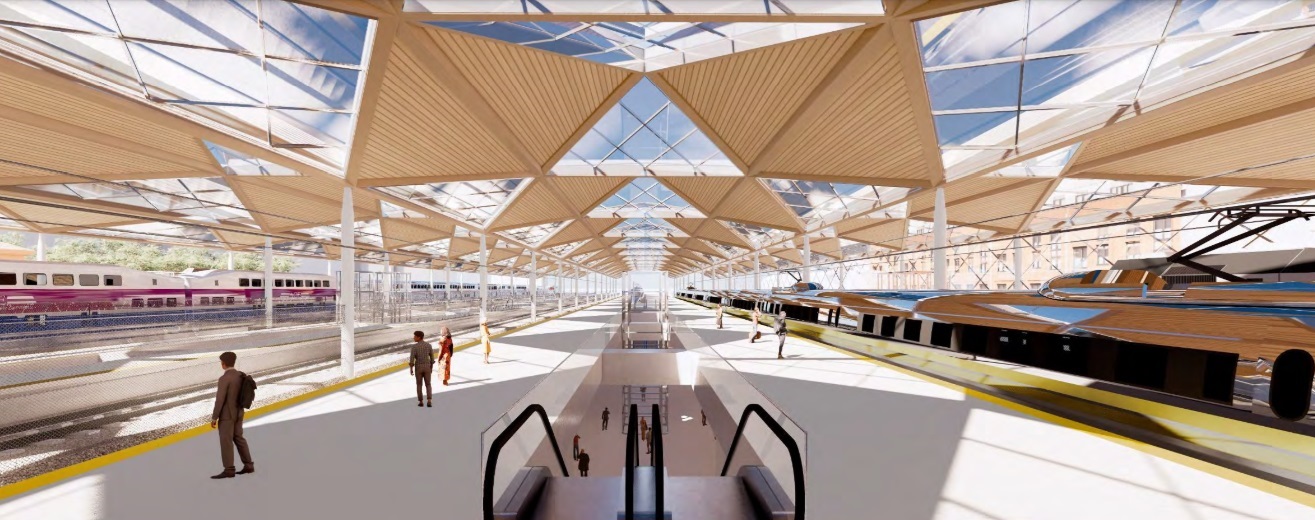With new cost estimates projected at $3 billion to $10 billion to transform Diridon Station into a “world-class” transit hub, a joint advisory committee with representatives from four transit agencies and the City of San Jose has narrowed its vision for the area to two concepts ahead of a public campaign to gain support for the massive project.
Diridon Station has become central to the economic vitality of San Jose’s western downtown area amid BART’s looming expansion into the South Bay. At the same time, Google’s ambitious vision for a transit village in the vicinity could bring millions of square feet of office and retail space and thousands of homes.
While Google has remained committed to moving forward, the company temporarily hit the pause button last year as it reassessed the project timeline.
The larger Diridon Station area is a 250-acre span that could accommodate more than 12,000 additional homes and tens of millions of square feet of office space anchored around the SAP Center and the station, which would serve as a one-stop shop for all transportation methods, including the future BART line and the proposed high-speed rail service connecting San Jose to the Central Valley.
The advisory committee — which consists of San Jose, the Santa Clara Valley Transportation Authority, Caltrain, the Metropolitan Transportation Commission and the California High-Speed Rail Authority — initially looked at three alternatives but nixed one option that proposed stacking train tracks at a significantly higher cost of up to $13 billion.
A ground-level design places a price tag for the project between $3 billion and $6 billion. An elevated-track design has a steeper economic hit at $5 billion to $10 billion. Design staff said the at-grade alternative is less expensive because there is a significant cost for building higher tracks, and it also requires less material.
“The goal here is to build on extensive outreach completed throughout the (Diridon Integrated Station Concept) process, build awareness and seek feedback that will help us select a recommended alternative by next summer,” said Caltrain planning manager Melissa Reggiardo.
Jim Ghielmetti, a board member of the High-Speed Rail Authority, said that while he was anxious to hear the public’s input, he favored the ground-level option. “I think cost is something we have to keep in mind,” he said.
Regardless of the design chosen next year, officials know that it will take a variety of funding sources to make the project a reality.
Some form of federal matching funds will be crucial to the project. But to get to that stage, the agencies will need local, regional or state funds, said Amitabh Barthakur, a partner at HR&A Advisors.
Barthakur said that while federal funding for capital projects typically requires at least a 20% local match, most cases are closer to 50%.
“It doesn’t mean that all of them are local, but probably other non-federal sources,” Barthakur said. “We’ll have to get really creative in cobbling together that stack of funding.”
Local officials have faced similar challenges with funding the $12.8 billion BART extension, which has seen costs and delivery dates swell throughout its planning phase.
While the BART project — which is separate from the Diridon Station redevelopment — recently received a $5.1 billion commitment from the Federal Transit Administration, it left a $700 million funding gap that transportation officials are still trying to plug.
Representatives from the agencies were unavailable to answer whether the FTA’s substantial financial commitment to BART could affect future local projects’ ability to compete for additional funding.
Along with direct contributions from local agencies and transit operators, VTA consultant Kim Walesh said there will likely be future conversations about new or extended tax measures.
Public-private partnerships could generate revenue for the maintenance and operations phases but are doubtful to be an option for construction, she said.
One of the most likely pathways to funding some of the project is through creating an Enhanced Infrastructure Financing District.
The hypothetical district would freeze property tax revenues for a defined region around the station going to the city and county and redirect any additional taxes generated to the government body in charge of the redevelopment.
Barthakur said that while there’s currently a soft market, a financing district with a one-mile radius around Diridon Station could generate significant future revenue and allow the redevelopment project to issue bonds between $200 million-$400 million.
Formation of tax-financing districts requires local governments to hold three public hearings and either gain at least 75% support from property owners or receive a majority vote during a “protest election.”
As the advisory board contemplates design and funding options, it must also select a governance option for overseeing the project’s construction after project consultants ruled out asking one of the partner transit agencies to serve as lead.
Walesh recommended creating a new entity through the state legislature that would dissolve upon completion after evaluating 10 transit and development projects, including the Salesforce Transit Center, Denver’s Union Station and the LA Metro Gold Line.
Related Articles
Housing highrise may replace office tower project in downtown San Jose
SJSU views San Jose housing tower as boost for students and downtown
Asian market will open first California store at San Jose retail center
Iconic East Bay hillside mansion is grabbed by mystery buyer from Tahoe
Council approves massive urban village development in North San Jose on former farmland
San Jose Mayor Matt Mahan said any governing board required a strong representation of elected officials, noting the importance of having people invested and available to advocate for it.
“I think ultimately, even if we are, in theory, ceding a certain amount of authority to this entity, we’re going to continue to need deep alignment and buy-in with the partner agencies and their departments and the folks on the other side who are doing execution,” Mahan said. “We’re going to continue to need political leadership likely to ultimately secure funding, whether from the public or other levels of government.”












